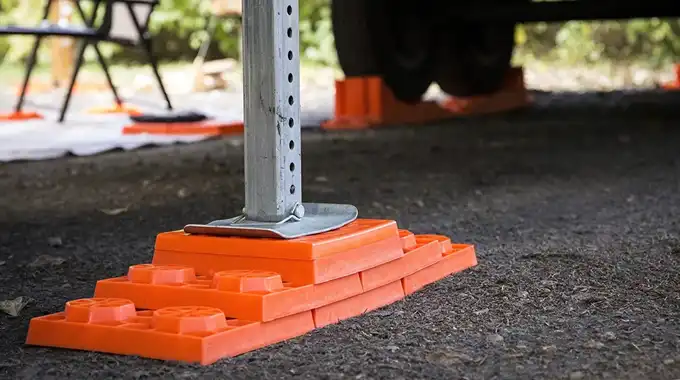Last Updated on April 12, 2023
If you are an RV owner, you know that a jack pad is one of the most helpful things to have. This is because jacking up your RV without a jack pad can cause serious irreparable harm to the vehicle. The shaking in an RV can cause things to fly around in the RV and even damage the vehicle.
Having a blown jack on your vehicle can leave you stranded on the side of the road. With the assistance of this simple instruction guide on “How to Make Jack Pads for RV,” you will be able to make your own jack pads for your RV in no time.
RV jack pads are easy to make and only take a few minutes to put together. These RV jack pads will stabilize your RV and keep it from shaking when you drive over bumps or potholes.
How to Make Jack Pads for Rv: Steps Involved
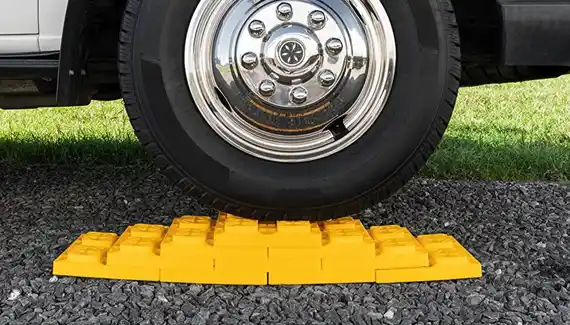
Jack pads are devices that are used to support a vehicle when it is being lifted. There are many different types of jack pads, but they all serve the same basic purpose. The most common type of jack pad is made from rubber or plastic.
- The first step in making an RV jack pad is to decide on the dimensions. The size of the RV jack pad will depend on the lifting application. For example, if the vehicle is being lifted from the front, the pad will need to be large enough to support the weight of the vehicle.
- Gather the necessary equipment to make your RV jack pad. This includes a sheet of metal, a marker, a saw, screws, and washers.
- Select the material for making your RV jack pad. The most common materials used for jack pads are rubber, metal, and plastic.
- Once the material and the dimensions have been decided, the next step is to make a proper cut of the material to size for your RV jack pad. This can be done with a saw or knife. If using a knife, it is important to be certain that the cuts are straight and clean.
- Cut the sheet of metal into four squares. The squares should cover the bottom of the jacks.
- Use the marker to draw circles on each of the squares. The circles will have to be big enough to cover the bottom of the RV jacks.
- Use the saw to make cut out the circles. Now that the bottom of the RV jack pad is complete, the next step is to attach the RV bottom. If using screws or nails, predrill holes to avoid splitting the material. Attach the four squares to the bottom of the jacks.
- The next step is to drill holes for attaching the pad to the RV. This will ensure that the pad stays in place while the vehicle is being lifted.
- Attach the RV jack pad to the vehicle. This can be done with screws, bolts, or adhesive. Make sure that the pad is securely attached before lifting the vehicle. The screws should be long enough to go through the metal, and the washers should be large enough to cover the holes.
If everything is secure, then the RV jack pads are ready to use. If not, then the process will need to be repeated until the jack pads are secure.
Why is Choosing Materials to Make RV Jack Pads Significant?

One of the most important factors in selecting materials for making RV jack pads is their ability to withstand a large amount of weight. The material must be strong and capable of supporting the vehicle’s weight without deforming or breaking.
RV Jack pads must be resistant to weathering and corrosion in order to provide durability over a long period of time. The material must be able to provide good traction to prevent the vehicle from sliding off the jack pad.
There are a variety of materials that can be used for making RV jack pads. Some common materials that can be used in the making of jack pads for an RV are rubber, plastic, foam, wood, metal, and concrete.
Rubber
Rubber is another material that is less commonly used to create RV jack pads. Like plastic, rubber is not as strong or durable as wood or metal.
Rubber has a number of advantages over plastic, including being more resistant to weathering and being more flexible, which can make it easier to fit into tight spaces.
Plastic
Plastic is a material less commonly used in RV jack pad making. The lightweight nature of plastic makes it easy to work with. It can be molded to get shaped and sized in a variety of ways. It is also much easier to work with than either wood or metal so it can be cut and shaped relatively quickly and easily.
Foam
Foam is a soft material that is sometimes used to create jack pads for RVs. It is not as durable or strong as wood, metal, or plastic, so it will not be able to support the full weight of an RV.
Foam is very light and easy to work with, which makes it possible to cut and shape it quite easily. Jack pads made out of foam are less likely to slip or slide than those made from other materials.
Wood
Wood is a common material used to make jack pads for RVs. It is strong and durable, making it ideal for supporting the weight of an RV. Wood is relatively inexpensive, making it a good option for those on a budget and shaped to fit any desired shape or size.
Metal
Metal is another material commonly used to make RV jack pads. Metal is also more difficult to work with than wood, so it may require more time and effort to cut and shape it to the desired size and shape.
Concrete
Concrete is a very strong and durable material, thus making it an ideal material for supporting an RV’s weight. Concrete is less expensive than metal, so it is an ideal choice for those on a budget.
How to Choose the RV Jack Pad Material?
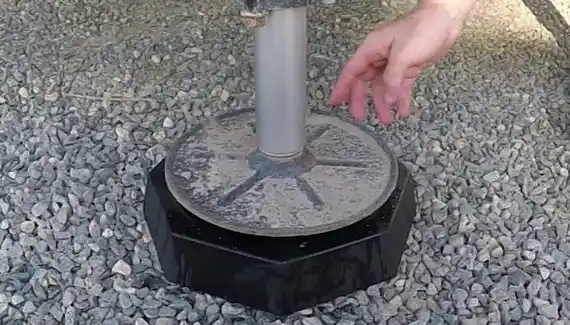
When choosing the material to make your jack pads for your RV jack, consider the weight of your RV and the conditions in which it will be used. If you are planning on using your RV jack pad in extreme weather conditions, it is important to choose a material that can withstand the elements.
If you are concerned about the traction of your RV, rubber is the best choice for making jack pads. Plastic may be the best choice when choosing a durable material that is easy to clean. The decision of which material to use for your jack pad is up to you and should be based on your specific needs and preferences.
Why Do You Need Jack Pads for an RV?
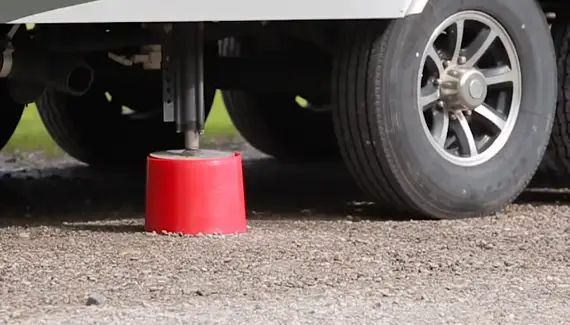
The reason it is necessary to use jack pads for an RV is that you don’t want to damage the underlying surface when you are jacking up your RV. Jack pads are a tool that is used to place under any RVs that have to be moved, and the jack is then used to help lift and move those heavy RVs.
Moving RVs with jacks helps to avoid damage to the surface that the object is being moved from. RV Jack pads are used as a landing spot for a jack when you are lifting or lowering a vehicle. They help to distribute the weight of the vehicle and protect the frame or body from being damaged.
Jack pads provide a protective barrier between the jacks and the surface, which helps to keep both the surface and the jacks in good condition. Jack pads can help to stabilize your RV while it is jacked up, which can be helpful if you are working on something underneath the RV or if you are simply parked on an uneven surface.
Using RV jack pads is a good way to protect your investment and to ensure that your RV remains in good condition for years to come.
What are the Dangers Associated with Using RV Jack Pads?
While RV jack pads can be effective at supporting vehicles, they can also be dangerous if they are not used properly.
- RV Jack pads are typically placed under the jack points on a vehicle in order to prevent damage to the vehicle’s frame or suspension.
- One of the risks associated with the use of RV jack pads is that they can slip or move out of place, which can cause the vehicle to fall and potentially injure someone.
- Another danger is that your RV can slide off of the jack pad if it is not positioned correctly.
- When the RV jack pad is not the correct size for the vehicle, it can break under the RVs weight and cause it to fall.
- If the RV jack pad is not placed on a level surface, it can topple over and cause the vehicle to fall. You should also place the RV jack pad on a level surface to prevent it from toppling over.
- If you are going to use an RV jack pad, it is essential to make sure that it is positioned correctly and that it is the right size for your vehicle. Improperly positioning your jack pads can put stress on the wrong parts of the vehicle, which can lead to damage.
- If an RV jack pad is not properly secured, it can come loose and become a projectile that could injure someone.
Can RVs be in Danger if They are not Parked on Jack Pads?
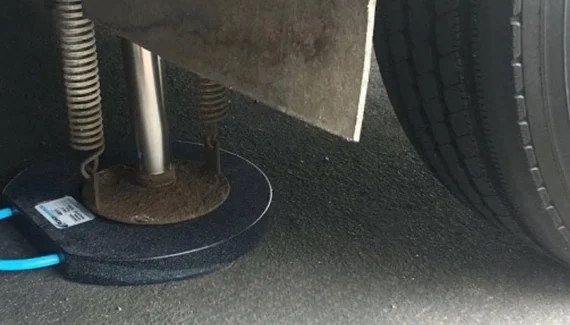
Jack pads are designed to distribute the weight of an RV evenly, preventing the jack from sinking into the ground.
- Without jack pads, the RV’s weight can cause the jack to sink into soft ground, making it difficult to remove the RV from its parking spot.
- Jack pads also help to prevent damage to the RV’s tires, as they provide a firm, level surface for the RV to rest on.
- Without the proper support of RV jack pads, your RV can become unstable and tip over, causing serious injury or even death.
- Not using jack pads can cause damage to your RV’s suspension and frame, as well as the tires.
- Not using RV jack pads can also result in a fine from some campgrounds or RV parks.
Considering all These
In this article, we went over how to make jack pads for RVs. Now that you know the RV jack pad process of how they are made, it is important also to understand why you need them. We talked about the steps involved and why choosing the material is important. If you follow these steps, you should be able to build your own Rv jack pad easily.
We hope our article has provided everything you need to know in order to create a set of durable and reliable jack pads and some additional helpful tips on making RV jack pads yourself. By this time, if you have decided that making your own RV jack pads is the way to go, be sure to follow all instructions carefully and take all precautions.
Remember, safety should always come first when working with tools and RVs. Do you have any tips on how to make or choose the best jack pads? Please share them with us. For more great tips and helpful information on camping and RVing, be sure to check out our other article postings. If you have any queries or thoughts, please do not hesitate to write them in the comments section.
